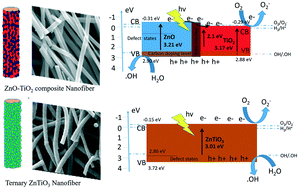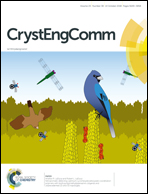ZnO–TiO2 composites and ternary ZnTiO3 electrospun nanofibers: the influence of annealing on the photocatalytic response and reusable functionality†
Abstract
The developments in environmental remediation based on the advanced oxidation processes of catalyst surfaces still endure the burden of the effective recombination of photoinduced charge carriers. The construction of defect band levels with heterostructural phases of catalytic nanostructures is a tenable strategy for separating photogenerated charge carriers and for minimizing carrier recombination. Herein, we explain an effective carrier separation rate with extended light absorption using electrospun ZnTi-based semiconducting nanofibers, which feature as composites and ternary form for their structural geometry. We explain the effective surface functionality with the design of the ZnO–TiO2 composite and ZnTiO3 as a function of the annealing temperature on electrospun fibers, and their commendable visible catalytic properties with the presence of defect states for degrading organic pollutants. The constructed ZnTiO3 in the form of nanofibers induced a narrow band gap of 3.01 eV as compared with its individual counterparts (ZnO (3.27 eV) and TiO2 (3.17 eV)). However, the composite functionality has an advantage in inducing discrete defect levels with the carbon impurities for favorable extended visible absorption with a similar morphological nature. Under visible irradiation, the ternary form of the nanofibers exhibited a photocatalytic degradation performance of around 72.45% and the composite fibers exhibited one of around 95.82% in 125 min due to the scrutinized function of the defect states that maximize the interfacial charge transfer between ZnO–C–TiO2 and delay the carrier recombination rate. The reliable mechanism behind the charge transfer of the photogenerated carriers was supported by trapping experiments of two different geometrical nanostructures on degrading organic pollutants. The interesting results obtained from the stability and reusability studies were that the ZnO–TiO2 composite nanofibers have a notably surface photocorrosive nature after catalytic reaction but the ternary ZnTiO3 form of the nanofibers has a stable surface stability with stable reusable catalytic functionality for up to 20 consecutive cycles. Constructing the nanostructures with tunable surface structural natures anticipates the broad possibilities in the photocatalytic realm for achieving improved visible catalytic responses with stable and reusable functionality over their single counterparts.



 Please wait while we load your content...
Please wait while we load your content...